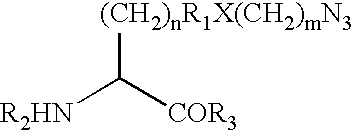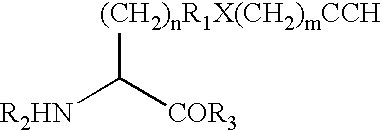Biosynthetic polypeptides utilizing non-naturally encoded amino acids
- Summary
- Abstract
- Description
- Claims
- Application Information
AI Technical Summary
Benefits of technology
Problems solved by technology
Method used
Image
Examples
example 1
[0759] This example describes a few of the many potential sets of criteria for the selection of preferred sites of incorporation of non-naturally encoded amino acids into GLP-1.
[0760] This example demonstrates how preferred sites within the GLP-1. polypeptide were selected for introduction of a non-naturally encoded amino acid. Sequence numbering used in this example is according to the amino acid sequence of GLP-1(7-37) shown in SEQ ID NO: 2. Position numbers cited are based positions 7-37 of the peptide unless otherwise indicated. For example, position 8 corresponds to the second amino acid in SEQ ID NO: 2. Those of skill in the art will appreciate that amino acid positions corresponding to positions in SEQ ID NO: 2, can be readily identified in SEQ ID NO: 1, 3, 21, or any other GLP-1 molecule.
[0761] Modeling of the potential alpha helical structure of GLP-1 was performed based on PDB ID 1JRJ from Neidigh, J. W., Fesinmeyer, R. M., Prickett, K. S., Andersen, N. H.: Exendin-4 and...
example 2
[0768] This example details expression of BSP including a non-naturally encoded amino acid in E. coli. Isolation of GLP-1 and production of GLP-1 in host cells is described in, e.g., U.S. Pat. No. 5,118,666, which is incorporated by reference herein.
[0769] An introduced translation system that comprises an orthogonal tRNA (O-tRNA) and an orthogonal aminoacyl tRNA synthetase (O-RS) is used to express BSP containing a non-naturally encoded amino acid. The O-RS preferentially aminoacylates the O-tRNA with a non-naturally encoded amino acid. In turn the translation system inserts the non-naturally encoded amino acid into BSP, in response to an encoded selector codon.
TABLE 2O-RS and O-tRNA sequences.SEQ ID NO: 4M. jannaschii mtRNACUATyrtRNASEQ ID NO: 5HLAD03; an optimized amber supressor tRNAtRNASEQ ID NO: 6HL325A; an optimized AGGA frameshift supressor tRNAtRNASEQ ID NO: 7Aminoacyl tRNA synthetase for the incorporation of p-azido-L-phenylalanine p-Az-PheRS(6)RSSEQ ID NO: 8Aminoacyl t...
example 3
[0772] This example details introduction of a carbonyl-containing amino acid and subsequent reaction with an aminooxy-containing PEG.
[0773] This Example demonstrates a method for the generation of a BSP that incorporates a ketone-containing non-naturally encoded amino acid that is subsequently reacted with an aminooxy-containing PEG of approximately 5,000 MW. For example, each of the residues identified according to the criteria of Example 1 for GLP-1 or Example 32 for T-20 is separately substituted with a non-naturally encoded amino acid having the following structure:
[0774] The sequences utilized for site-specific incorporation of p-acetyl-phenylalanine into GLP-1 are any of those described in Example 1 and SEQ ID NO: 4 (muttRNA, M. jannaschii mtRNACUATyr), and 16, 17 or 18 (TyrRS LW1, 5, or 6) described in Example 2 above. The sequences utilized for site-specific incorporation of p-acetyl-phenylalanine into T-20 are any of those described in Example 32 and SEQ ID NO: 4 (muttRN...
PUM
| Property | Measurement | Unit |
|---|---|---|
| Temperature | aaaaa | aaaaa |
| Temperature | aaaaa | aaaaa |
| Power | aaaaa | aaaaa |
Abstract
Description
Claims
Application Information
 Login to View More
Login to View More - R&D
- Intellectual Property
- Life Sciences
- Materials
- Tech Scout
- Unparalleled Data Quality
- Higher Quality Content
- 60% Fewer Hallucinations
Browse by: Latest US Patents, China's latest patents, Technical Efficacy Thesaurus, Application Domain, Technology Topic, Popular Technical Reports.
© 2025 PatSnap. All rights reserved.Legal|Privacy policy|Modern Slavery Act Transparency Statement|Sitemap|About US| Contact US: help@patsnap.com



